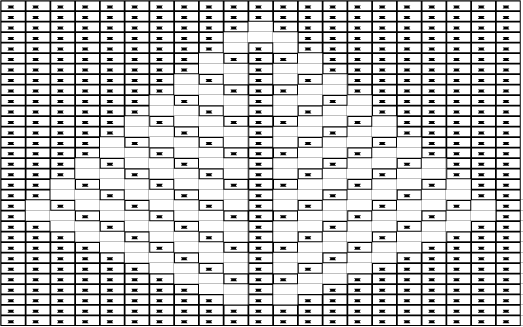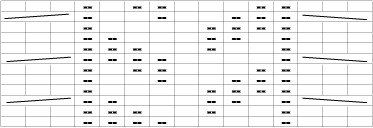Yarn:
Wullenstudio’s Superwash Sock Yarn in Green Tamborine colorway
Needles:
2.25 mm (I used a long circular needle to do magic loop, but use what you feel comfortable with.)
Gauge:
8.5 sts of st st = 1 in. (worked in the round.)
Charts:



Toe:
- Using provisional cast on, cast on 14 sts onto one needle.
- Knitting back and forth on two needles, work 6 rows of st st.
- Knit across the 14 sts on needle.
- Pick up 4 sts along side of rectangle.
- Knit the 14 sts from cast on edge.
- Pick up 4 sts along other side of rectangle. You will now be knitting in the round until you get to the heel flap. You now have 36 sts total.
- Knit next 16 sts. Place marker.
- Knit next 18 sts. Place marker.
- K1, M1, K until 1 st before marker, M1, K1.
- Repeat toe step #9 for other side of toe.
- K entire round.
- Repeat toe steps #9 through #11 until you have 72 sts.
Foot:
Starting with the center stitch of the Ivy and Cable chart, work half of that chart, the first row of the Tree chart, and then the other half of the Ivy and Cable chart, moving the stitch marker over by one stitch. Work the rest of the round in st st. Work the charts for the top of the foot, and st st for the sole of the foot. Please note, the two charts do not sync up, so pay attention.
To determine where to stop working the foot and to start working the foot flap, measure what you have knit against your forearm. If the part of your forearm that is not covered by the sock is the same as the width of the sock, you are ready to move on to the foot flap, turning after finishing the sole stitches.
Foot Flap:
- K3, P32.
- P3, *K1, sl 1, rep from * to the last 4 sts, K4.
- K3, P32.
- P3, *sl 1, K1, rep from * to the last 3 sts, K3.
- Repeat foot flap steps #1 through 4 8 more times (36 rows in all).
Heel Turn:
- Sl 1, P18, P2tog, P1, turn.
- Sl 1, K4, ssk, K1, turn.
- Sl 1, P to 1 st before gap, P2 tog, P1, turn.
- Sl 1, K to 1 st before gap, ssk, K1, turn.
- Repeat heel turn steps # 3 and 4 until all sts are worked.
Heel Pickup:
You are going back to working in the round.
- Pick up 18 sts down side of foot flap.
- Pick up 1 st on each side of gap between foot flap and top of foot. Slip marker.
- Continue working pattern for top of foot. Slip marker.
- Pick up 1 st on each side of gap between top of foot and foot flap.
- Pick up 18 sts up side of foot flap.
- Determine the center stitch of those on the foot flap side of the two markers. Knit to 15 sts after that center stitch. Place a marker. (Don’t include the center stitch in the 15 count.)
- Knit until 2 sts before marker for top of foot. Ssk. Slip marker.
- Continue working pattern to next marker. Slip marker. K2tog.
- Knit until 15 sts before the center stitch from heel pickup step #6. Place marker.
Gussets:
You now have divided up the sock into four areas, the top of foot, the two gussets, and the heel. For the heel portion (where you just left off,) work the same slip stitch pattern that you did for the foot flap (just the slip stitch pattern, omitting the garter stitch edge. Also, since you are now working in the round, those purl rows are now knit rows, but you probably already knew that.) For the top of the foot, continue working the charts. For the gussets,
- Work heel sts to next marker. Slip marker.
- Knit until 3 sts before marker, k2tog, K1, slip marker.
- Work charts to next marker. Slip marker.
- K1, ssk, knit to next marker. Slip marker.
- Work heel sts to next marker. Slip marker.
- Knit to next marker. Slip marker.
- Work charts to next marker. Slip marker.
- Knit to next marker. Slip marker.
- Continue gusset steps #1 through 8 until you have 72 sts.
- Continue working steps #5 through 8 until you are ready to start the tree chart on the back of the sock (or just want to start working the pattern on the back of the leg,) stopping 7 sts short of the marker for the top of foot patterning.
Leg:
Work the Ivy and Cable chart from whatever row you left off on when working the top of foot, then work the Tree chart, then the Ivy and Cable chart, and then the Tree chart again. Then keep using the charts to work the leg of the sock until it about one-half inch shorter than you want the leg of the sock to be.
The last chart is to give you an idea of how the patterns fall on the sock. The area with the white background is the top of foot, which becomes the front of leg. The green shaded area of the chart is the back of leg. Hopefully, that chart is of some help.
Cuff:
Now, it is just one-half inch of 1×1 ribbing (K1, p1.) Cast off. (I use the tubular cast off, as it is pretty elastic.)
If there are any questions, just put them in the comments or email me, and I will try to answer them with my usual “clear as mud” explanations.
Copyright 2009 by G. P. Donohue for textillian.com
Comments
4 responses to “Tannenbaum Socks Pattern”
Thank you for your thorough instructions and charts. These will be the perfect Christmas socks. I hope you and your family have a Happy Easter.
Wow — Patrick, thank you so much for sharing all of this hard work with us – I’m going to print it if OK with you! What a beautiful pattern!
Thanks again,
Joan
PS Hope to get to SnK tonight! (fingers crossed)
Just FYI, I have made a few corrections to the pattern thanks to my friend Karen’s proofreading. Thanks, Karen!
What a great pattern! I love trees and so much try these!